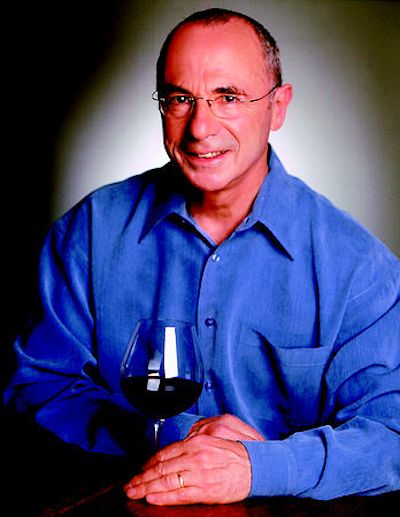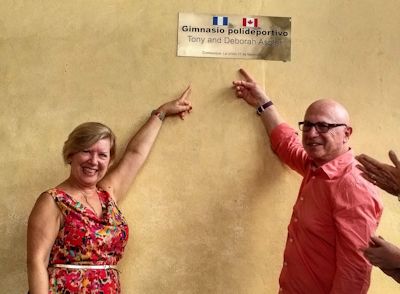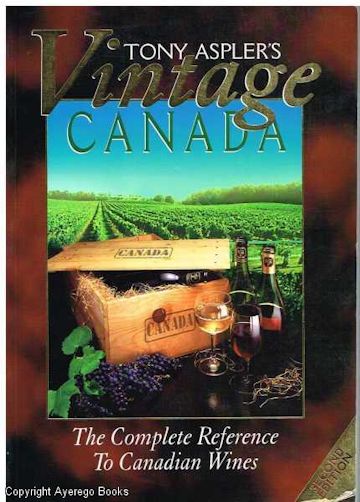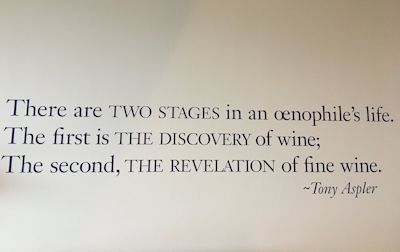

Tony Aspler ~ The Wine Guy
Born London England
Married to Deborah Benoit Aspler
First Book Vintage Canada 1982
In 1995, the Ontario Wine Awards were founded by Tony Aspler
In 2007, the Wine Media Guild established the Wine Writers’ Hall of Fame to recognize and honour, by induction, individuals who have made significant contributions to the body of wine writing and education. Each year, individuals who have had exceptional careers and significant achievements as wine authors, journalists or educators are nominated and elected by a committee of their peers. Consideration is on a global basis. Previous Inductees include, among others: Michael Broadbent, Robert Parker, Kevin Zraly, Steven Spurrier, Matt Kramer, Hugh Johnson, Jancis Robinson, James Halladay, Peter Sichel, Gerald Boyd, Dan Berger, Ed McCarthy and Karen MacNeil.
In 2012 Tony was the first Canadian to be inducted into the New York Media Wine Writers Hall of Fame. In that year Tony was awarded the Queen’s Jubilee Medal.
Grapes for Humanity

Grapes for Humanity Canada raises funds to benefit humanitarian causes around the world, with the assistance of the international wine community.Through wine tastings, auctions, dinners and other wine-related activities, they raise funds for the less fortunate around the world. Proceeds from these events go directly to those in immediate need.
The focus of Grapes for Humanity Canada has expanded to embrace those in need as a result of natural disasters, economic hardship and children at risk. The foundation is particularly interested in the welfare and education of children in the Third World

Deborah and Tony Aspler, opening a High School in La Union, Guatemala

Tony's Books
Vintage Canada (3 editions) – 1982 (Prentice-Hall)
International Guide to Wine (with John C. Lindsay) – 1986 (Prentice-Hall)
The Wine Lover’s Companion (3 Editions) – 1991 (McGraw Hill-Ryerson)
Cellar & Silver (with Rose Murray) – 1993 (McGraw Hill-Ryerson)
The Dinner Companion (with Jacques Marie) – 1993 (McGraw Hill-Ryerson)
Aligoté To Zinfandel – 1994 (McGraw Hill-Ryerson)
Guide to New World Wines – 1996 (McGraw Hill-Ryerson)
Travels With My Corkscrew - 1997 (McGraw Hill-Ryerson)
A Taste for Wine (a book on tape) - 1999
The Wine Lover Cooks (with Kathleen Sloan) – 1999 (MacMillan)
Canadian Wine for Dummies – 2003 (Wiley)
The Chef’s Table (with Lucy Waverman and James Chatto) – 2000 (Random House)
The Wine Atlas of Canada – 2006 (Random House)
The Definitive Canadian Wine Cheese Cookbook (with Gurth Pretty) – 2007 (Whitecap)
Tony Aspler’s Cellar Book - 2009 (Random House)
North American Wine Routes (with Dan Burger) – 2010 (Readers Digest)
Canadian Wineries (with photographer Jean-François Bergeron) - 2013 (Firefly)
The Five Minute Wine Book – 2014 (ebook)
The Tony Aspler Cuvée Award of Excellence
Presented to the individual or institution that best furthers the aims and aspirations of Ontario’s wine industry
Prior Winners of the Tony Aspler Cuvée Award of Excellence
2000 - Peter Gamble
2001 - Donald Triggs
2002 - John Ralston Sal
2003 - Karl Kasier
2004 - Paul Bosc Sr.
2005 - Carlo Negri
2006 - WIlliam Lenko
2007 - Jim Warren
2008
- Lanny Huff
2009 - Darryl Brooker
2010 -
John O'Gryzlo
2011 - Bill Redelmeier
2012 -
Ron Giesbrecht
2013 - Terrance Van Rooyen
2014 - Moray Tawse
2015 -
Laurie McDonald
2016 - Lloyd Schmidt
2017 - Ian D'Agata
2018 - Sue - Ann Staff
Tony Aspler Wine Services
31 Oarsman Crescent,
St. Catharines, Ontario L2N7.
M4R 3J9
Tony Aspler can provide the following wine services for you: Corporate and private wine tastings Client appreciation wine tastings Food and wine dinners Wine evaluations for estate or insurance purposes Wine auctioneering Staff training in wine service Consulting on wine lists and menus
His thoughts on Ontario wine Industry
What has caused this sea change in Ontario wines?
There are basically five factors, one of them accidental.
The watershed year for the transformation was 1988 and the introduction of Free Trade. The signing of the General Agreement on Tariffs and Trade meant a phasing out of tariffs on imported wines that had hitherto protected the local industry. Wineries in Ontario and British Columbia would have to compete with the wines of the world on an equal playing field. (The nascent wine regions of Quebec and Nova Scotia were not yet on the radar.) Up until this time, provincial governments had given guarantees to grape growers that their crops would be sold to wineries at negotiated prices; those grapes rejected by winemakers would be purchased by the government for distillation into industrial alcohol.
There was no incentive for the growers to move from hybrids to the noble vinifera varieties, although a few dedicated growers such as John Marynissen and Bill Lenko in Ontario had proven that you could grow and sustain Cabernet Sauvignon and Chardonnay in a marginal climate using the right viticultural practices.
With the evaporation of trade barriers, the industry gave a collective shudder and convinced itself the sky was falling. Their response to this gloom-and-doom scenario—which turned out to be the right response—was to look at their vineyards and decide what they should get rid of. Ontario reduced its vineyard acreage from 24,000 to 17,000. In the same year as the Free Trade Agreement, the Wine Content Act in Ontario was revised and labrusca varieties were banned from table wines (they could still be used for “pop” wines, such as Baby Duck, and for faux sherry and port).
If you have ever tasted Concord grape juice, you will be familiar with an aroma and taste of labrusca grapes. When fermented, these varieties, like Niagara and Isabella, give off a smell that the wine community calls “foxy.” The marker for labrusca-based wines is a chemical called methyl anthranilate. It’s a hard smell to define—I have never been close enough to a fox to confirm this descriptor. Thomas Pinney, in ‘A History of Wine in America: From the Beginnings to Prohibition (1989)’, quotes the Russian-born American winemaker Alexander Brailow: “People have tried to compare the smell and taste to things that they know. In Russia, for instance, they say that the grape Isabella, which is grown extensively in Crimea for red wine, smells like bedbugs. It all depends on the association and personal taste.”
Isabella, incidentally, was the variety most responsible for the spread of phylloxera through the vineyards of Europe in the 1860s. Cuttings of this vine contaminated with the phylloxera louse were shipped to the Rhône Valley for planting because of its resistance to powdery mildew,a fungus that had afflicted French vineyards from the 1850s.The scourge of phylloxera laid waste the vineyards of Europe. Its estimated damage: two and one half times the cost of the Franco-Prussian War. Ironically,the saviour of Europe’s vines was the very cause of the initial disaster. North American labrusca varieties are immune to the depredations of the phylloxera louse. Now virtually all European vines are planted on North American rootstock.

on the wall at the Niagara
College Wine Education Centre
What I have learned in my pursuit of the grape through my columns I can distil into the following incontrovertible rules.
1. Wine always tastes better in the presence of the wine maker.
2. The bottle you drop will not break. It will bounce and hit the most expensive wine in your cellar which will break.
3. A great wine will taste terrific even out of a Wellington boot.
4. A $100 wine will not taste ten times as good as a $10 wine.
5. Champagne is the only alcoholic beverage you can drink for breakfast and nobody will look sideways at you.
6. You can drink red wine with fish but not with kippers.
7. The bottle of cooking sherry you found in your grandmotherís attic is worth exactly what she paid for it.
8. Donít save a cherished bottle for the great occasion. None will ever be great enough and the wine will turn to vinegar. Cheers!
Tony Aspler’s website can be found at www.tonyaspler.com and www.iWineandDine.com .
Resources
Tony Aspler
Tonyaspler.com
Grapes for Humanity
Numerous news articles
Home | About |Sitemap | History| Ontario |New | Contact Us |Tourism |©2018 Robert A Bell